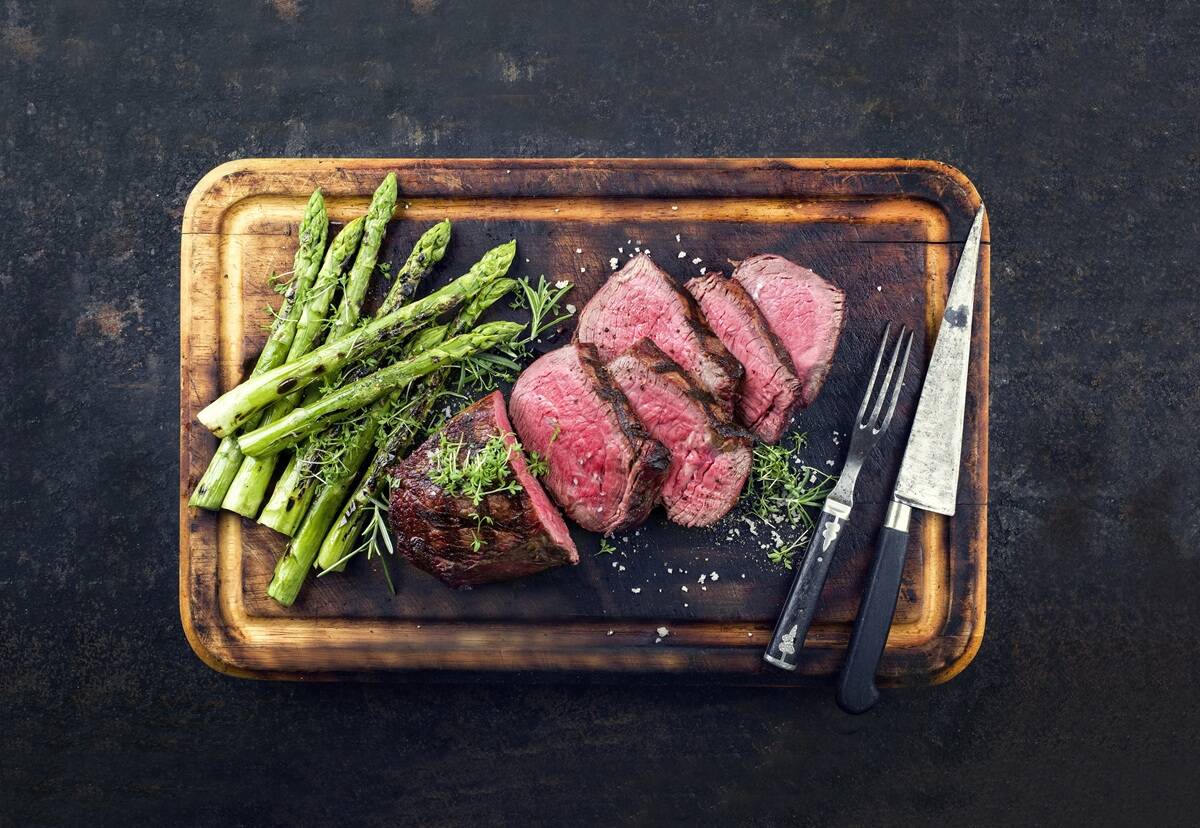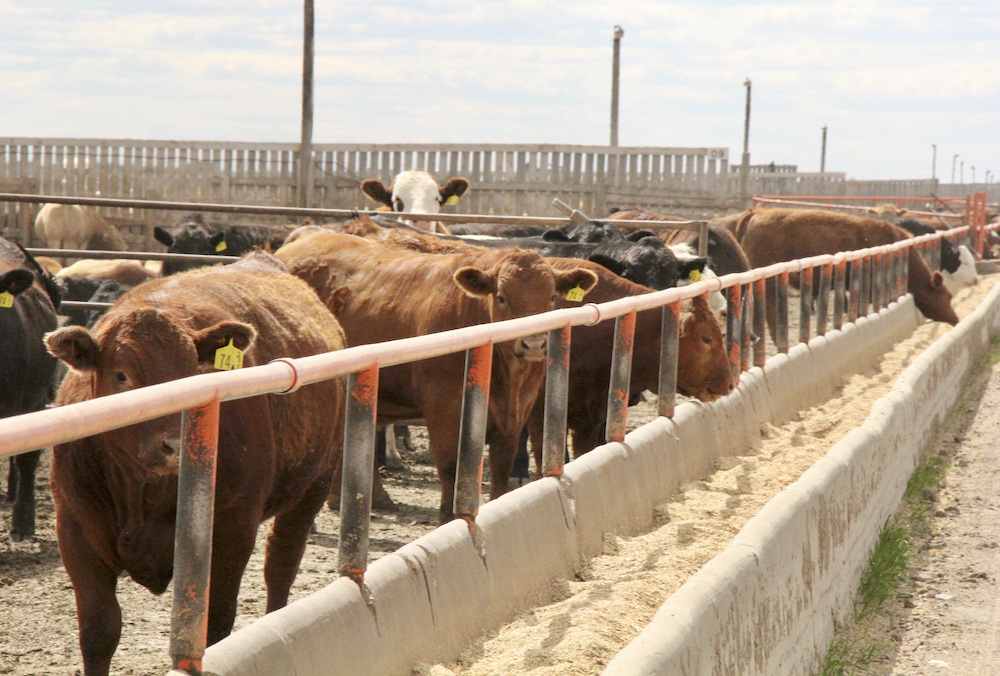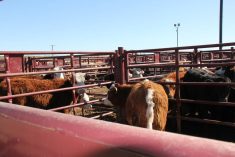Wheat is notorious for being a highly fermentable cereal grain and its inclusion in finishing feedlot diets is often restricted to avoid digestive disorders such as rumen acidosis and bloat. Adverse growing conditions frequently result in wheat grain with elevated mycotoxin levels that fail to meet the standard for human consumption.
But such wheat may still be suitable as livestock feed. Unlike swine and poultry, ruminants are less sensitive to the deoxynivalenol (DON) mycotoxin produced by Fusarium graminearum (also known as fusarium head blight or scab). According to the Canadian Food Inspection Agency (CFIA), wheat containing DON up to 10 ppm can be fed to cattle. The incorporation of mycotoxin-infected grains (within this limit) in feedlot diets can limit losses for grain producers while still providing a valuable energy source for feedlot cattle.
Furthermore, feedlots can incur benefits from incorporating wheat into feedlot diets as it is usually higher in protein than either barley or corn and often higher in starch than barley. Higher-protein hard wheat may have a greater value for cattle during the growing phase, supporting muscle development. The higher starch content of soft wheat may offer advantages over barley during the fattening phase. This pattern reflects the fact that the nutritional demand for protein diminishes during the finishing phase, while the energy demand to support fat deposition increases.
Read Also

Building demand together: The impact of Canada’s beef import levy
The beef import levy has become a central tool for ensuring balance in Canada’s beef industry
While a persuasive case for wheat-based feedlot diets can be advocated, concerns surrounding its ability to promote digestive upsets must be addressed. As well, there may be value in matching specific wheat types to the growing and finishing phases of feedlot cattle production.
Digging into digestive disorders
The goal of our research was to investigate the effect of grain-processing method and nutritional composition of wheat on the growth performance and the occurrence of ruminal acidosis and liver abscesses in feedlot cattle fed wheat grain-based growing and finishing diets.
Growth performance can be hindered by fermentable grains triggering digestive disorders such as ruminal acidosis, free-gas bloat, rumenitis and liver abscesses. Rapid microbial fermentation of starch in the rumen can lead to an accumulation of short-chained fatty acids, causing a condition known as subacute ruminal acidosis (SARA) if the rumen pH declines to between 5.8 to 5.2 for more than 12 hours per day. Chronic reductions in ruminal pH can impair rumen motility, reduce the belching of gases and result in free-gas bloat. Ruminal acidosis can also induce rumenitis as a result of erosion of the ruminal epithelium and contribute to the development of liver abscesses.
Grains are typically processed by grinding or rolling to increase digestibility by reducing particle size and disrupting barriers that prevent ruminal microbes from gaining access to the starch harboured within the endosperm. Dry rolling reduces the particle size of grains by crushing kernels, cracking the seed coat and pericarp by passing kernels through two alternating rollers. However, hard kernels tend to shatter during processing under the pressure required to break these peripheral barriers to starch digestion. This can generate fine particles that increase fermentability and the risk of ruminal acidosis. Tempering — where kernels are soaked in water for up to 24 hours to increase the moisture content to about 20 per cent to soften the endosperm — can reduce shattering.
Variations between the kernel texture of wheat types (hard versus soft) determine how much force is needed to disrupt the kernel. Low-protein wheat cultivars tend to have softer kernels and require less force to fracture kernels. Greater resistance to processing is typically observed for high-protein wheat which has harder kernels and is more likely to generate fine particles during dry rolling. Temper rolling can help promote a more consistent particle size distribution for hard kernel wheat by softening the endosperm and reducing the formation of fine particles.
Our study examined the effect of feeding beef steers high-protein (18 per cent CP) or low-protein (13 per cent CP) wheat that had been either dry or temper rolled to a processing index of 75 per cent (give or take three per cent). The processing index is the ratio of the weight of rolled grain divided by the weight of the whole kernels, measured at a constant volume. We used 160 Angus-cross steers distributed in 16 feedlot pens to assess growth performance, feeding behaviour and ruminal health. Steers were fed a backgrounding diet for 84 days (35 per cent wheat grain, 60 per cent barley silage and five per cent supplement) and then transitioned to a finishing diet (85 per cent wheat grain, 10 per cent barley silage and five per cent supplement) for 140 days. Diets were on a dry matter basis.
Results
High-protein wheat had harder kernels than low-protein wheat and produced more fine particles than low-protein wheat after rolling. Tempering increased the particle size of wheat, especially high-protein wheat. Hard wheat needs to soak in the water for longer as its high-protein content slows the rate that water is absorbed into the kernel. These results demonstrate that temper rolling can be beneficial in the processing of hard wheat as fewer fines will reduce the risk of digestive disorders. Dry rolling may be sufficient for soft wheat types that are less likely to generate fine particles during processing.
Temper rolling also reduced the duration that steers fed high-protein wheat experienced a low ruminal pH during the transition from the backgrounding to the finishing diet, but this response was not observed for low-protein wheat. Furthermore, high-protein wheat grain improved the feed efficiency and net energy available for the gain of backgrounding steers, supporting the need for higher levels of dietary protein for muscle growth at this stage of production. In contrast, greater average daily gains were observed for finishing steers fed the low-protein wheat diets, likely due to its higher starch content. Supplying ruminal microbes with more highly digestible starch can increase the amount of energy available for fat deposition.
One of the more surprising results of this study was the effect of protein content on liver abscesses. Although the occurrence of total liver abscesses was not affected by diet, abscesses were more severe in steers fed the high- as compared to low-protein wheat. High levels of protein in the diet may increase the energetic demand for the liver to convert ammonia into urea, thereby reducing the amount of energy available to support immune responses that prevent liver abscess formation.
Profitability is vital in promoting the use of wheat grain in beef cattle diets. This can be accomplished by maximizing growth performance while limiting the risk of digestive disorders. For growing cattle, high-protein wheat may be more suitable, while low-protein wheat may be more suitable for finishing cattle. Temper rolling of high-protein wheat can be used to avoid the generation of fines that increase the risk of digestive upsets. Finally, using lower-protein wheat may reduce the severity of liver abscesses that form during finishing.
Amanda Meadows is a University of Saskatchewan graduate student who is completing her program under the supervision of Drs. Tim McAllister and Gabriel Ribeiro.
















